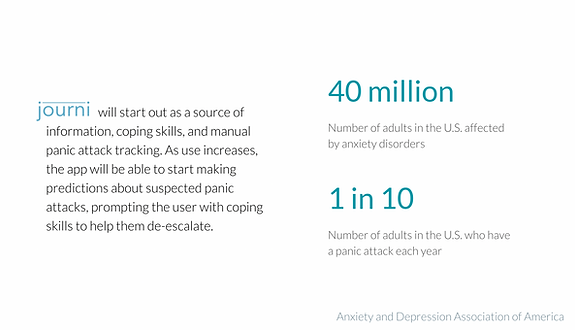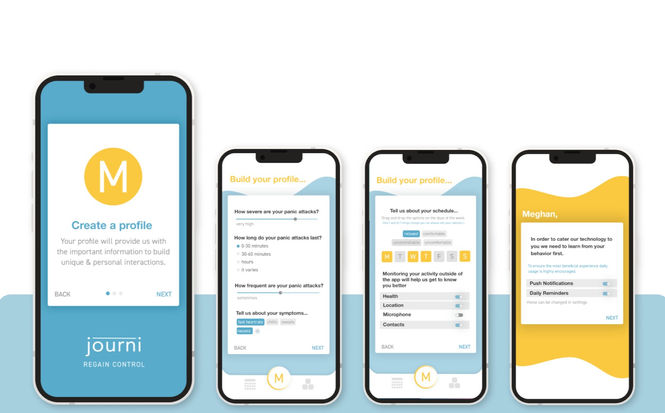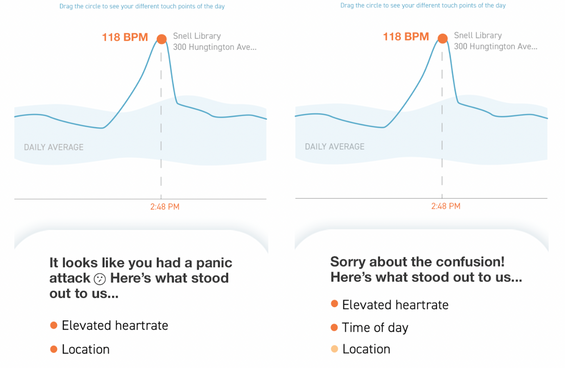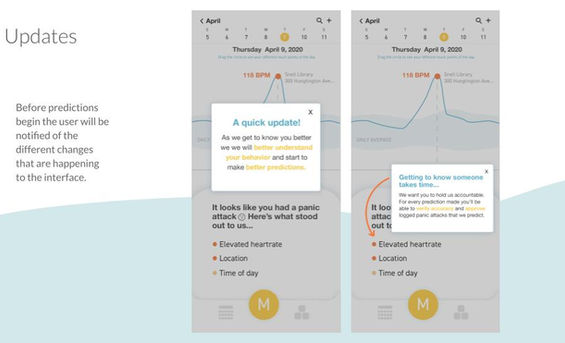CLICK TO EXPAND
Designing for AI Experiences
Journi is a proof of concept for a panic attack prevention and mitigation application. With my teammate, I was able to conduct ethnographic research, gather data, and design a mobile application for AI experiences.
Throughout this course I learned valuable information about AI algorithmic functions, and best UI UX design practices for AI. Although this class did not offer curriculum on coding skills, we were able to gather a heuristic understanding of back-end development and how algorithms influence design decisions.
Check out the Journi pitch here.
PROCESS
01 RESEARCH
Research potential areas of related to health & wellness that could benefit from an AI intervention
04 PROTOTYPE
Create low fidelity prototypes that specifically incorporate AI signifiers and affordances to conduct user research
02 MENTAL MODEL
Create mental model around how Ai works in general and how it will play into prevention and mitigation for panic attacks
05 REFINE
Adjust product to incorporate user feedback as well as branding and design
03 CONCEPT
Concept application and it's UI infrastructure for the 3 key phases of our Ai model
06 PITCH
Create an identity for journi that encompasses research about panic attack scientific studies and AI algorithm models
process breakdown
RESEARCH & IDEATION
The main priority for this project was understanding the specifications of designing for AI experiences. For two weeks we completed literature reviews of case studies for both Artificial Intelligence algorithmic functions and UI UX design specifications for AI. Once my partner and I had an understanding of these practices we chose to apply this knowledge by creating a design solution for panic attack prevention and mitigation.
Before the conceptualizing what form this solution would take, we conducted enthographic research like surveys, interviews, and self tracking to determine the variety of pain points someone experiences before, during, and after a panic attack.

Concept &
Mental Models
Creating user personas and journey maps of different use cases, my partner and I identified how AI could be implemented to solve for panic attack prevention and mitigation.
We created a mental model that mapped out how our application would work on the back end and brainstormed the different ways the interface would evolve with the users data. This allowed us to start designing with AI in mind but keep the user at the forefront of our priorities.

View our Mental Model Appendix
Phase segmentation
From our mental model of the evolution of use for Journi, I began creating the phases of UI infrastructure for the onboarding, data collecting, and predictions stages of the app. This involved a lot of research on the language surrounding AI and which aesthetic decisions signified our (and the algorithm's) call to actions from the user. Additionally, we explored what notifications and initial pop ups would aid in the users understanding of the apps evolution.
This portion of the project was intentionally the most time consuming as we needed to create an infrastructure that grew with our user while still remaining cohesive.
View our Predictions Appendix
CLICK TO EXPAND
REFINEMENTS
Before updating the design, we were able to collect user feedback by sending the mock up to friends, family, and the Northeastern health and wellness facebook group. We were aware that there is a stigma about openly talking about personal disorders and mental health, so we knew it might be difficult to get people to open up about how this idea could influence an individual's experience with panic attacks. Luckily, we were able to get feedback from users who actively experience this issue which led to impactful refinements. After implementing the necessary changes, we enhanced the branding to finalize the concept.
CLICK TO EXPAND















